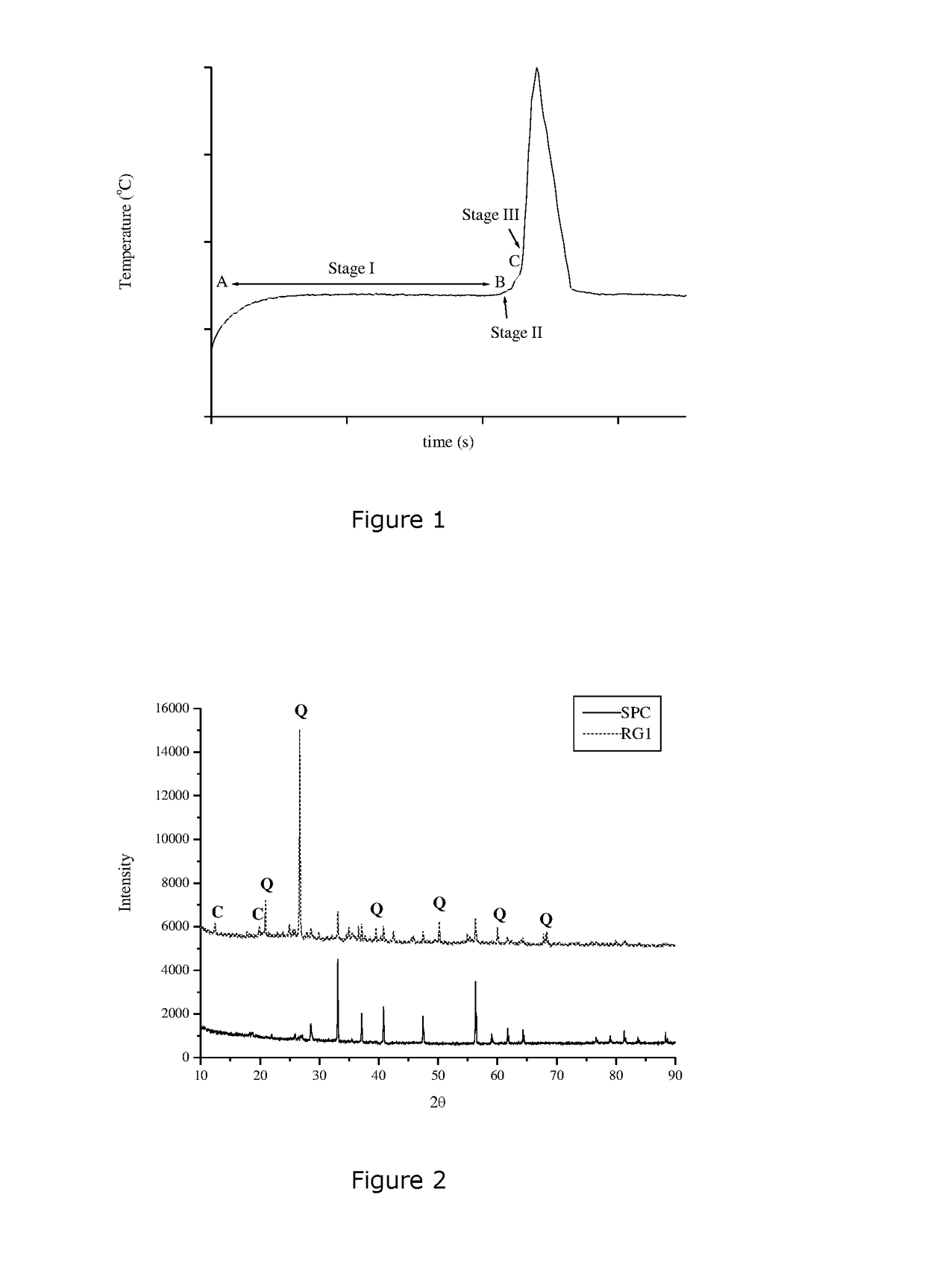Blasting agent
a technology of nitrate-based explosives and blasting agents, which is applied in the direction of blasting, explosives, weapons, etc., can solve the problems damage to workers working on the shot, and inability to safely and effectively use such blasting agents, so as to reduce the accumulation of nox in the explosive, accelerate the exothermic reaction, and eliminate or at least reduce the effect of nox gas accumulation
- Summary
- Abstract
- Description
- Claims
- Application Information
AI Technical Summary
Benefits of technology
Problems solved by technology
Method used
Image
Examples
example 1
[0137]An emulsion containing 74.3 wt % AN, 4.9 wt % urea, 14.4 wt % water and 6.3 wt % oil phase was made. The oil phase used was a mixture of 15 wt % PIBSA emulsifier and 85 wt % diesel fuel oil. This emulsion was used as the standard emulsion for this Example.
[0138]Hydrotalcite (HT) purchased from Sigma was calcined at 550° C. for 4 hours. The calcined HT was wetted with a hydrocarbon mixture containing 15 wt. % PIBSA emulsifier. This HT-oil mixture contained 33.3% oil phase (including emulsifier). This oil coated HT was then mixed with the standard emulsion to make an inhibited emulsion containing 4.65 wt % HT by weight.
[0139]The standard and HT added emulsions were then tested in accordance with the standard system isothermal test at 130° C. using ground samples from Newman, Western Australia. The period from when the sample was added to the heating block and the maximum of temperature raise is considered the induction time.
[0140]Addition of HT increased the induction time from ...
example 2
[0141]An emulsion containing 72.93 wt. % AN, 1.54 wt. % urea, 19.6 wt. % water and 5.92 wt. % oil phase was manufactured. The oil phase used contained 65 wt. % dodecane, 14 wt. % PIBSA DEEA emulsifier and 21 wt. % diesel. This emulsion was used as the standard emulsion for this Example.
[0142]Uncalcined HT was then mixed with the same oil phase (containing 14 wt. % PIBSA DEEA emulsifier) to make a mixture containing 71.3 wt. % HT. This oil coated HT was then well mixed with a portion of the standard emulsion to make an emulsion containing 1.2 wt. % HT.
[0143]The standard emulsion and the HT added emulsion were tested for induction periods at 55° C. in a closed system adiabatic calorimeter. In brief, the test samples (about 4.7 g and done in duplicate) were prepared by mixing samples of the standard and the HT added emulsions with pure pyrite purchased from Spectrum. The pyrite was wetted with a solution containing Fe(II) and Fe(III) ions according to the AEISG Code, respectively. This...
example 3
[0144]An emulsion containing 70.7 wt. % AN, 19.9 wt. % water and 9.9 wt. % oil phase was prepared. The oil phase used was dodecane containing 10.6% PIBSA DEEA1100 emulsifier and 16% diesel. This emulsion was used as the standard emulsion for this Example.
[0145]A sample of Hydrophobic HT, (purchased from Sigma) (0.05 g) was mixed well with a portion of the emulsion (10 g) to make a HT added emulsion, which finally contained 0.50% HT. (This hydrophobic HT was not wetted with PIBSA before addition to the emulsion).
[0146]The reference emulsion and the HT added emulsion were tested for induction periods at 55° C. The test samples were prepared by mixing the emulsions with reactive ground received from Dyno Nobel, according to the isotherm test method. The samples (neat emulsion+reactive ground and HT added emulsion+reactive ground) were then held at 55° C. using the adiabatic calorimeter until reaction occurred.
[0147]It was found that addition of 0.50% HT to the neat emulsion increased t...
PUM
| Property | Measurement | Unit |
|---|---|---|
| size | aaaaa | aaaaa |
| temperature | aaaaa | aaaaa |
| temperature | aaaaa | aaaaa |
Abstract
Description
Claims
Application Information
 Login to View More
Login to View More - R&D
- Intellectual Property
- Life Sciences
- Materials
- Tech Scout
- Unparalleled Data Quality
- Higher Quality Content
- 60% Fewer Hallucinations
Browse by: Latest US Patents, China's latest patents, Technical Efficacy Thesaurus, Application Domain, Technology Topic, Popular Technical Reports.
© 2025 PatSnap. All rights reserved.Legal|Privacy policy|Modern Slavery Act Transparency Statement|Sitemap|About US| Contact US: help@patsnap.com



